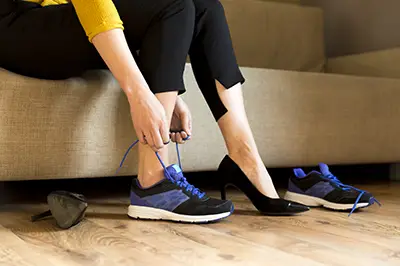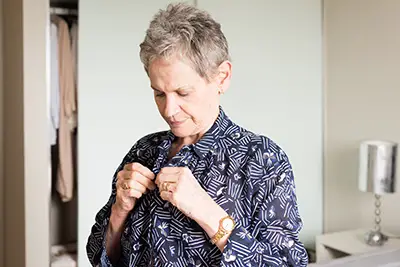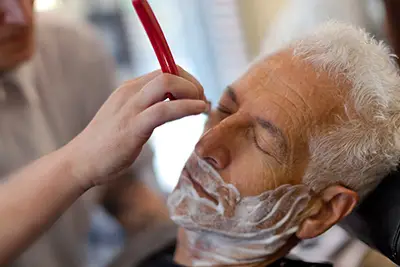
What are the best dressing and grooming tips for caregivers?
As a caregiver, it is important to dress and groom yourself properly for a professional aesthetic. In addition, the life of a caregiver may get occasionally messy, therefore you must prepare yourself for anything that may happen during your shifts.
In this article, we will cover how personal caregivers should present themselves through tips on dress and grooming.
Define Grooming & the Grooming Process
It is important for caregivers to understand the definition of grooming and the expected grooming process as it relates to healthcare. The specific grooming meaning may be different between individuals depending on each person’s cultural and social backgrounds.

When caring for a senior, the caregiver needs to assess what the person’s personal grooming understanding currently is, their cultural, religious or other background circumstances related to the proper grooming process and each patient’s current ability to carry out those necessary grooming tasks on a day-to-day basis.
Everyone’s activities of daily living should include basic personal grooming habits that make an individual feel neat and clean when in public settings. There are some strategies that caregivers can use to help their elderly patients perform their necessary personal bathing/dressing habits based on each person’s understanding and specific physical abilities or limitations.
Additionally, any caregiver working with seniors should follow some practical, important and commonsense daily grooming habits to help protect their elderly patients from an allergic reaction or other adverse response.
How Personal Caregivers Should Dress When Working With Seniors
Every person performing any type of direct care with seniors should pay attention to the needs of their clients that they will be caring for each day. Seniors often develop extreme allergies, skin sensitivities and other issues that are triggered by various environmental factors.

For example, allergies to perfumes found in just about any grooming product can set off a severe asthma or bad allergy attack that could be dangerous in those with weakened systems. It is important that caregivers limit the amount of fragrances and other known patient allergy triggers for the best results.
Care providers should also dress in comfortable clothing like scrubs or other looser attire. As many older patients have weaker immune systems, it is also essential for the caregiver to ensure that they have showered each day. Clean clothing should be worn to work every day as working as a direct caregiver tends to put the attendant or nurse into close bodily contact with others throughout the day.
It is not acceptable to show up for work wearing dirty clothing or dressed inappropriately. Comfortable shoes are also a must, as heels, flip-flops and other unsafe footwear can put not only the caregiver at grave risk of injury, the person being cared for can also be harmed if the caregiver slips during a patient transfer.
The Dangers of Inappropriate Dressing for Caregivers & Their Senior Care Recipients
There are some dangers of inappropriate dressing that both caregivers and the senior care recipients should be aware of. If a young woman dresses in skin-baring clothing while caring for an elderly person who has strict religious or cultural beliefs regarding how a woman dresses is one example of something that should be seriously considered.
Caregivers can simply ask their patients what these beliefs are to avoid disrespect in someone’s own living environment. If the elderly person is not able to communicate well, the caregiver can ask a family member for tips.
Inappropriate dressing of your senior patient can happen if the person is not dressed for the weather appropriately or could be construed if the patient is wearing clothing unsuited for the hour or place like wearing nightgowns all day long. Remember that your patient should always be treated with the utmost respect, and helping them look presentable and clean is one of the most important care duties that each caregiver has.
How to Dress Older Care Recipients That Have Dementia

Patients with dementia often become very confused when attempting to dress appropriately. They might pick out mismatched outfits or appear to be unable to define grooming or seems to misunderstand someone else’s grooming meaning. They may also have great difficulty with understanding proper dressing definition as they seem to have no idea regarding dressing to suit the weather for example.
There are some simple and practical ways that caregivers can help their elderly patients to express their own dressing definition and help the patient dressing to reduce that common sense of confusion and panic many elderly dementia patients show when doing their daily grooming and dressing routines.
Some tips for simplifying the dressing process include:
- Making sure they have clean outfits
- Give the person two or three choices in those clean outfits – the choice helps the patient feel in control, and keeping the choices low and simple is easier for the patient
- Coordinate clothing in the closet – or layout several coordinated outfits each day
- Try to find appropriate preferences in dress that your patient finds important – let them wear favorite color
- Use friendly conversation and distraction techniques to keep the person’s anxieties lower
There may be times when the caregiver should really just pick their battles. If the person is staying in and not expecting company, it might be alright to allow the person to wear their favorite clothing even if they are insisting on mismatched outfits.
Why Personal Grooming Should Be an Essential Part of Daily Care Plans for Seniors

Personal caregivers are responsible for ensuring that their patient’s personal bathing and dressing routines get done appropriately. Perhaps it is not necessary for your patient to get a fully bath every day, but they should make sure that they have washed critical body parts every day for cleanliness factors.
It is important to try to understand why you patient might not want to shower, shave or brush their teeth. Sometimes the person is simply afraid for some reason to get into the shower. Relying any problems noticed with patient bathing and other grooming tasks should be done quickly by notifying your supervisor family member.
Some Additional Tips for Caregivers to Use When Determining How to Dress Older Patients Properly
- Make fun bathing/grooming/dressing routines
- Keep things simplified & organized
- Learn how to use distraction to keep the person calm during baths or during other dressing tasks
- Consider going to adaptable clothing – there is clothing with zippers, Velcro closures and so forth
- Be extremely gentle as elder patient’s skin is often frail and easily torn
- Allow your patient to participate as much as possible to maintain their independence
Caregivers can help their patients with their individualized dressing and grooming routines by implementing some of these practical strategies. Allowing your patient to perform as many personal bathing or grooming tasks can help them feel less frustrated or anxious regarding their emotional health.
More terrific ideas on caregiver dressing and/or grooming tips can be found at https://www.inhomecare.com online 24/7.



